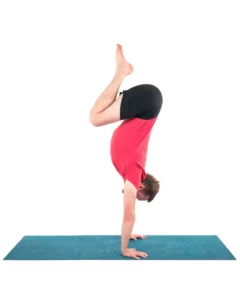Bird Dog Pose Variation: Bend Back and Balance

Article At A Glance
Bird Dog Pose (Parsva Balasana) is a deceptively complicated pose. It may look simple from the outside, but it packs a lot of benefits into a single asana. This Bird Dog Pose variation strengthens the abdominal and back muscles, promotes balance, and stretches the chest, shoulders, and hip flexors.
Bird Dog Pose (Parsva Balasana) is a deceptively complicated pose. It may look simple from the outside, but it packs a lot of benefits into a single asana. I’ll reiterate its array of benefits here:
- Strengthens and stabilizes the core
- Strengthens the low back
- Challenges, and therefore increases, your ability to balance
- It may promote balance between the right and left lobes of your brain through the contralateral relationships between the arms and legs
In today’s post, we’ll look at a variation of the Bird Dog Pose, one that we can practice along with the traditional pose version. The instructions below will coach you on moving from traditional Parsva Balasana to this backbending variation.

Bird Dog Pose Variation: A Backbend Plus Balancing Pose
Like the original Bird Dog Pose, this variation confers all the above benefits. But it also extends the lumbar spine, lengthens the quadriceps and hip flexors, and expands the chest and shoulders. The transition from classic Bird Dog Pose to this variation is yet another balancing challenge, which, of course, helps you develop your balancing skills.
Some practitioners may need help to reach their foot with their hand. In this case, you can use a yoga strap to make the connection. If you’re teaching this variation in a class, you can loop the strap around the lifted foot and then hand the student the two ends of the strap so that they can hold it with their opposite hand.
If you’re practicing on your own and would like to use a strap, you’ll need to enter the pose directly from Bharmanasana (Tabletop Pose) rather than the traditional Bird Dog Pose. I’ll explain the process below.

How to Practice Bird Dog Pose Variation
- Come to your hands and knees on a yoga mat. Place a folded blanket under your knees for extra padding.
- Extend your right leg straight back, straightening your knee. There’s no need to try to lift the leg above your pelvis. This can actually cause stress in your lower back. Let your leg be parallel to the floor.
- Extend your left arm forward, straightening your elbow. Again, there’s no need to hyperextend your shoulder joint by lifting your hand higher than your torso.
- Ground firmly through your right palm and left knee, shin, and foot, rooting them into your mat.
- Simultaneously extend the right leg backward and left arm forward, keeping the back of your neck long and drawing your hyoid bone back into the throat.
- Stay for 3 to 5 deep breaths, continuing to ground the right palm and left knee, shin, and foot as you extend the left arm and right leg.
- Now bend your right knee, pointing your foot toward your head.
- Reach your left hand back toward or to the foot. It’s okay if you can’t reach your foot. You can still benefit from stretching your left arm back toward your foot. Alternatively, you can return to all fours and follow the yoga strap instructions below.
- Press your right foot into your left hand to help expand your chest and shoulder.
- Take 3 to 5 deep breaths in the pose.
- Return to all fours. Rest here if you like, feeling the effects of the pose. You can also rest in Child’s Pose (Balasana) if you prefer.
- Practice Bird Dog Pose on the other side.

How to Use a Yoga Strap to Reach Your Foot
This maneuver can be a bit tricky. It might take some practice, but making the hand-to-foot connection can add some extra strength to the pose.
- Start on all fours on a yoga mat. Feel free to place a folded blanket under your knees for extra padding.
- Loop a yoga strap around the front of your right ankle and extend the ends of your strap along the floor diagonally toward your left hand. The strap should pass over your left calf, and the ends of it should be on the outside of your left knee. A longer (8-foot or 10-foot) yoga strap might work best here, depending on the length of your torso, although a 6-foot strap will be okay for most people.
- Take ahold of the ends of the strap with your left hand.
- Then, lift your right leg, your knee still bent. Simultaneously, lift your left arm and extend it back toward your foot. You may need to walk your hand back on the strap to take up the slack.
- Stay in the pose for 3 to 5 deep breaths, pressing your foot into the strap to help open your shoulder.
- Release the pose and rest on all fours.
- Repeat on the other side.
Also, read...
Teaching Svadhyaya: 3 Ways to Encourage Self-Study in Yoga
In Celebration of Gray-Haired Yoga – Busting the Myth of the Yoga Body
Related courses

Charlotte Bell began practicing yoga in 1982 and began teaching in 1986. She was certified by B.K.S. Iyengar in 1989 following a trip to Pune. In 1986, she began practicing Insight Meditation with her mentors Pujari and Abhilasha Keays. Her asana classes blend mindfulness with physical movement. Charlotte writes a column for Catalyst Magazine and serves as editor for Yoga U Online. She is the author of two books: Mindful Yoga, Mindful Life, and Yoga for Meditators, both published by Rodmell Press. She also edits Hugger Mugger Yoga Products’ blog and is a founding board member for GreenTREE Yoga, a non-profit that brings yoga to underserved populations. A lifelong musician, she plays oboe and English horn in the Salt Lake Symphony and the folk sextet Red Rock Rondo whose 2010 PBS music special won two Emmys.



